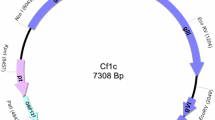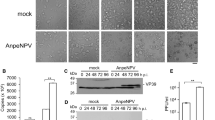Summary
The KP6 toxin of Ustilago maydis, encoded by segmented double-stranded (ds) RNA viruses, is lethal to sensitive strains of the same species and related species. The toxin consists of two polypeptides, α and β, synthesized as a single preprotoxin, which are not covalently linked. Neither polypeptide alone is toxic, but killer activity can be restored by in vitro and in vivo complementation. Killer-secreting strains are resistant to the toxin they produce. Resistance is conferred by a single recessive nuclear gene. This study describes a search for cytoplasmic factors that may confer resistance, also referred to as immunity. The approaches used to detect cytoplasmic immunity included transmission of dsRNA and transmission of virus particles to sensitive cells by cytoduction, cytoplasmic mixing in diploids and infection with viruses. An alternative approach was also used to express cloned cDNAs of the KP6 toxin-encoding dsRNA and of the α and β polypeptides. The results indicated that no immunity to KP6 can be detected. While KP6, α and β polypeptides were expressed by resistant cells, neither KP6 nor β were expressed in sensitive strains. The α polypeptide was expressed in sensitive cells, but it did not confer immunity. These results suggest that neither the preprotoxin nor the α or β polypeptides confer immunity and thus β may be the toxic component of the binary toxin.
Similar content being viewed by others
References
Ben-Zvi BS, Koltin Y, Mevarech M, Tamarkin A (1984) RNA polymerase activity in virions from Ustilago maydis. Mol Cell Biol 4:188–194
Boone C, Bussey H, Greene D, Thomas DY, Vernet T (1986) Yeast killer toxin: site-directed mutations implicate the precursor protein as the immunity component. Cell 46:105–113
Bostian KA, Eillott Q, Bussey H, Burn V, Smith A, Tipper DJ (1984) Sequence of the preprotoxin dsRNA gene type 1 killer yeast: multiple processing events produce a two-component toxin. Cell 36:741–751
Bussey H, Saville D, Greene DJ, Bostian KA (1983) Secretion of Saccharomyces cerevisiae killer toxin: processing of the glycosylated precursor. Mol Cell Biol 3:1362–1370
Bussey H, Boone C, Zhu H, Vernet T, Whiteway M, Thomas DY (1990) Genetic and molecular approaches to synthesis and action of the yeast killer toxin. Experientia 46:193–200
Chang TS, Banerjee N, Bruenn JA, Held W, Peery T, Koltin Y (1988) A very small viral dsRNA. Virus Genes 2:195–206
Day PR (1981) Fungal virus populations in corn smut from Connecticut. Mycologia 73:379–391
Diamond ME, Dowhanick J, Nemeroff ME, Pietras DF, Tu CL, Bruenn JA (1989) Overlapping genes in a yeast dsRNA virus. J Virol 63:3983–3990
Dmochowska A, Dignard D, Henning D, Thomas DY, Bussey H (1987) Yeast KEXI gene encodes a putative protease with a carboxypeptidase B-like function involved in the killer toxin and a-factor precursor processing. Cell 50:573–584
El-Sherbeini M, Bostian KA (1987) Viruses in fungi: Infection of yeast with the K1 and K2 killer virus. Proc Natl Acad Sci USA 84:4293–4297
Eng W-K, Faucette L, Johnson RK, Sternglanz R (1988) Evidence that the DNA topoisomerase I is necessary for the cytotoxic effects of camptothecin. Mol Pharmacol 34:755–760
Field LJ, Bruenn JA, Chang TH, Pinhasi O, Koltin Y (1983) Two Ustilago maydis viral dsRNA of different size code for the same product. Nucleic Acids Res 11:2765–2778
Finkler A, Koltin Y, Barash I, Sneh B, Pozniak D (1985) Isolation of a virus from virulent strains of Rhizoctonia solani. J Gen Virol 66:1221–1232
Fujimura T, Wickner RB (1988) Gene overlap results in a viral protein having an RNA binding domain and a major coat protein domain. Cell 55:663–671
Ginzberg I (1990) The Ustilago maydis killer system: The organization of the toxin encoding genes and characterization of their products. PhD thesis, Tel-Aviv University, Israel
Holiday R (1961) The genetics of U. maydis. Genet Res 2:204–230
Kinal H, Tao J, Bruenn JA (1991) An expression vector for the phytopahtogenic fungus, Ustilago maydis. Gene 98:129–134
Koltin Y (1988) The killer system of Ustilago maydis: Secreted polypeptides encoded by viruses. In: Koltin Y, Leibowitz M (eds) Viruses of Fungi and Simple Eukaryotes. Marcel Dekker, New York, pp 209–242
Koltin Y, Day PR (1976) Inheritance of killer phenotype and double-stranded RNA in Ustilago maydis. Proc Natl Acad Sci USA 73:594–598
Koltin Y, Kandel JS (1978) Killer phenomenon in Ustilago maydis: The organization of the viral genome. Genetics 88:267–276
Koltin Y, Mayer I, Steinlauf R (1978) Killer phenomenon in Ustilago maydis: mapping viral functions. Mol Gen Genet 166:181–186
Koltin Y, Levine R, Peery T (1980) Assignment of functions to segments of the dsRNA genome of Ustilago maydis. Mol Gen Genet 178:173–178
Lolle SJ, Skipper N, Bussey H, Thomas DY (1984) The expression of cDNA clones of yeast M1 double-stranded RNA in yeast confers both killer and immunity phenotypes. EMBO J 3:1383–1387
McKoen F (1991) When worlds collide: Immunosuppressant meet protein phosphatases. Cell 66:823–826
Peery T, Koltin Y, Tamarkin A (1982) Mapping the immunity function of the Ustilago maydis P1 virus. Plasmid 7:52–58
Peery T, Shabat-Brand T, Steinlauf R, Koltin Y, Bruenn J (1987) Virus-encoded toxin of Ustilago maydis: two polypeptides are essential for activity. Mol Cell Biol 7:470–477
Puhalla JE (1968) Compatibility reactions on solid medium and interstrain inhibition in Ustilago maydis. Genetics 60:461–474
Puhalla JE (1969) The formation of diploids of Ustilago maydis on agar medium. Phytopathology 59:1771–1772
Schmitt ME, Brown TA, Trumpower BL (1990) A rapid and simple method for preparation of RNA from Saccharomyces cerevisiae. Nucleic Acids Res 18:3091–3092
Seroussi E, Peery T, Ginzberg I, Koltin Y (1989) Detection of killer independent dsRNA plasmids in Ustilago maydis by a simple and rapid method of extraction of dsRNA. Plasmid 21:216–225
Smith TL, Leong SA (1990) Isolation and characterization of a Ustilago maydis glyceraldehyde-3-phosphate dehydrogenaseencoding gene. Gene 93:111–117
Sturley SL, Elliot Q, LeVitre J, Tipper DJ, Bostian KA (1986) Mapping of functional domains within the Saccharomyces cerevisiae type 1 killer preprotoxin. EMBO J 5:3381–3389
Tao J, Ginzberg I, Banerjee N, Held W, Koltin Y, Bruenn JA (1990) Ustilago maydis KP6 toxin: Structure, expression in Saccharomyces cerevisiae, and relationship to other cellular toxins. Mol Cell Biol 10:1373–1381
Thomas JO, Kornberg RD (1975) An octamer of histones in chromatin and free in solution. Proc Natl Acad Sci USA 72:2626–2630
Tsukuda H, Carleton S, Fotheringham S, Hollman WK (1988) Isolation and characterization of an autonomously replicating sequence from Ustilago maydis. Mol Cell Biol 8:3703–3709
Wang J, Holden DW, Leong SA (1988) Gene transfer system for the phytopathogenic fungus Ustilago maydis. Proc Natl Acad Sci USA 5:865–869
Ward AC (1990) Single-step purification of shuttle vectors from yeast for high frequency back-transformation into E. coli. Nucleic Acids Res 8:5319
Wickner RB (1986) Double-stranded RNA replication in yeast: the killer system. Annu Rev Biochem 55:373–395
Widgerson M, Koltin Y (1982) Dual toxin specificities and the exclusion relations among the Ustilago dsRNA viruses. Curr Genet 5:127–136
Zhu H, Bussey H (1991) Mutational analysis of the fuctional domains of yeast kl killer toxin. Mol Cell Biol 11:175–181
Zhu H, Bussey H, Thomas DY, Gagnon J, Bell AW (1987) Determination of the carboxyl termini of the a and (3 subunits of yeast kl killer toxin. J Biol Chem 262:10728–10732
Author information
Authors and Affiliations
Additional information
Communicated by C.P. Hollenberg
Rights and permissions
About this article
Cite this article
Finkler, A., Peery, T., Tao, J. et al. Immunity and resistance to the KP6 toxin of Ustilago maydis . Molec. Gen. Genet. 233, 395–403 (1992). https://doi.org/10.1007/BF00265436
Received:
Issue Date:
DOI: https://doi.org/10.1007/BF00265436




